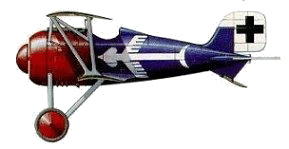|


The SSW D.III was
designed as a fast-climbing interceptor and was to make use of the new
11 cylinder Siemens-Halske 160hp counter-rotary engine. This engine
featured a propeller and cylinders that rotated opposite to the
crankcase, allowing a slower propeller speed for the same power and the
elimination of torque among other things. Initial tests of the Sh.III
engine in the SSW D.IIb saw the remarkable (for the time) climb of
7000m in 35 minutes, and the decision was made to design a new
interceptor around it.
Tests with the prototype D.III fitted with a two-bladed propeller and
long undercarriage that typified the first incarnation of the type.
showed that ground handling left a lot to be desired, therefore a new
four-blade propeller and shorter u/c were soon to be standardised on
the production D.III. In tests against the Fokker D.VII and Albatros
D.V, the SSW D.III was the faster of the three.
The first pre-production batch was ordered on 26 December 1917 and were
numbered D.8340/17 -D.8359/17. In April-May 1918 40 D.IIIs and one D.IV
were sent to Jagdgeschwader II for evaluation.
Although the tests of the D.III and D.IV in combat had shown the type
to be excellent climbers, it was felt they could be faster and more
manoeuvrable. And when it worked the combination of SSW D.III airframe
and Sh.III engine was 'faultless'. However after just 10 hours of
operation the engines began to overheat, have pistons seize and
crankcases shatter. The problem was traced to a bad batch of oil, but
the damage was done and the D.III was withdrawn from service for
upgrading. As it was withdrawn from service, the words of the JG.II
commander, Hptm Rudolf Berthold, rang out "the Siemens fighter be made
available again for Front-line use as quickly as possible for, after
elimination of the present faults, it is likely to be become one of our
most useful fighter aircraft."
At the factory the SSW D.III was now fitted with a new rudder, new
ailerons, shorter wings, the engine cowl was cut away on the bottom for
improved cooling and other, less visible modifications were made. The
Sh.III engine was also banned from frontline service pending a 40-hour
test.... This was completed in July and the type returned to service at
the end of July.
After the modified D.III and D.IVs were evaluated the decision was now
made to assign the bulk of the fast climbing SSW D.IIIs to the home
defence Kests and the faster, more manoeuvrable D.IV to frontline
Jastas.

The most famous D.III
is that of Ltn Ernst Udet, however it is unknown if it was ever flown
in combat. The name on the side is that of his fiancée Elanore 'Lolo'
Zink, and was carried on all his aircraft in 1917-18. Udet survived the
war with a total of 62 victories.
Siemens Schuckert
D.III
Manufacturer: Siemens-Schuckert
Type: Fighter
Engine: 1 x Siemens-Halske SH.III 160 hp.
Wingspan: 8.40 m
Length: 5.75 m
Weight: 534 kg/725 kg
Max. speed: 180 km/h
Ceiling: 8000 m
Crew: 1
Armament: 2 x machineguns |
